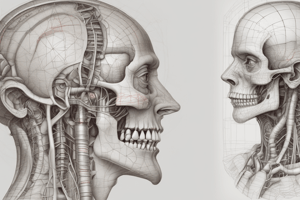Podcast
Questions and Answers
What is the site where a nerve fiber meets a muscle fiber to supply it called?
What is the site where a nerve fiber meets a muscle fiber to supply it called?
Motor end plate
Define a motor unit in the context of skeletal muscles.
Define a motor unit in the context of skeletal muscles.
A motor unit consists of a motor neuron and all muscle fibers that it innervates.
What are muscle spindles and tendon spindles responsible for?
What are muscle spindles and tendon spindles responsible for?
Conveying information regarding muscle tension to the central nervous system.
What is the function of the sensory fibers in skeletal muscles?
What is the function of the sensory fibers in skeletal muscles?
What happens if a nerve trunk of a muscle is severed?
What happens if a nerve trunk of a muscle is severed?
Flashcards are hidden until you start studying
Study Notes
Body Cavities
- The thoracic cavity is divided into:
- Left and right pleural cavities, each containing one lung and lined by visceral and parietal pleura
- Mediastinum, which contains the pericardium (pericardial cavity) and surrounds the heart
- The abdominopelvic cavity is lined by the peritoneum and divided into:
- Abdominal cavity, which extends from the diaphragm to the superior margins of the pelvis and contains organs such as the liver, stomach, spleen, and large intestine
- Pelvic cavity, which is bordered by the pelvis and contains organs such as the reproductive organs, urinary bladder, and the final portion of the large intestine
Body Regions
- The body can be divided into:
- Head
- Neck
- Trunk (thorax and abdomen)
- Pelvis
- Limbs (upper and lower)
- The body can also be divided into four quadrants:
- Right Upper Quadrant (RUQ)
- Left Upper Quadrant (LUQ)
- Right Lower Quadrant (RLQ)
- Left Lower Quadrant (LLQ)
Body Systems
- The body has several systems, including:
- Integumentary system (dermatology)
- Skeletal system (osteology)
- Articular system (arthrology)
- Muscular system (myology)
- Nervous system (neurology)
- Circulatory system (Angiology, including cardiovascular and lymphatic systems)
- Digestive or alimentary system (gastroenterology)
- Respiratory system (pulmonology)
- Urinary system (urology)
- Reproductive or genital system (gynecology for females and andrology for males)
- Endocrine system
Bone
- Functions of bone:
- Nourishing the external surface of bones
- Laying down more bone (especially during fracture healing)
- Providing an interface for attachment of tendons and ligaments
- Histological types of bone:
- Compact bone
- Spongy (trabecular or cancellous) bone
- Classification of bone by organization:
- Axial (skull, vertebral column, thorax)
- Appendicular (pectoral girdle, pelvic girdle)
- Classification of bone by shape:
- Long bones (found in limbs, e.g., humerus, femur, metacarpals, metatarsals, and phalanges)
- Short bones (found in hands and feet, e.g., scaphoid, lunate, talus, and calcaneum)
- Flat bones (found in the vault of the skull, e.g., frontal and parietal bones)
- Irregular bones (found in the vertebrae, and the pelvic bones)
- Sesamoid bones:
- Small nodules of bone found in certain tendons where they rub over bony surfaces
- Examples include the patella, and sesamoid bones in the tendons of the flexor pollicis brevis and flexor hallucis brevis
- Function: reduce friction on the tendon and alter the direction of pull of a tendon
Cartilage
- A type of connective tissue with cells and fibers embedded in a gel-like matrix
- Firm and resilient, except on exposed surfaces in joints, where a fibrous membrane called perichondrium covers the cartilage
- Types of cartilage:
- Hyaline cartilage (found in tracheobronchial, articular cartilage of typical synovial joints, and epiphyseal growth plates of bones)
- Fibrocartilage (found in intervertebral discs, the labrum of the shoulder and hip joints, the menisci of the knee joints, and at the articular surface of bones)
- Elastic cartilage (found in the external ear, auditory tube, and epiglottis)
- Cartilage lacks blood supply, and its cells are nourished by diffusion through the ground substance
Ligaments
- Cords of connective tissue uniting two structures
- Commonly found in association with joints
- Fibrous ligaments prevent excessive movement in a joint
Joints
- A site where two or more bones come together
- Classified into three types based on the tissues that lie between the bones:
- Fibrous joints (bones are joined by fibrous tissue, with very little movement possible)
- Cartilaginous joints (bones are united by a plate or bar of cartilage, with two types: primary and secondary)
- Synovial joints (bones are united by a plate of fibrocartilage and the articular surfaces of the bones are covered by a thin layer of hyaline cartilage)
- Types of synovial joints:
- Plane joints (e.g., sternoclavicular and acromioclavicular joints)
- Hinge joints (e.g., elbow, knee, and ankle joints)
- Pivot joints (e.g., atlantoaxial and superior radioulnar joints)
Skeletal Muscles
- Nerve supply:
- Mixed nerves supply skeletal muscles
- Motor fibers stimulate muscle fibers to contract
- Sensory fibers arise from specialized sensory endings in muscle spindles and tendon spindles
- Sympathetic fibers regulate blood flow to the muscle
- If a nerve trunk is severed, the muscle cannot contract and will lead to paralysis of the muscle and loss of muscle tone
Studying That Suits You
Use AI to generate personalized quizzes and flashcards to suit your learning preferences.




